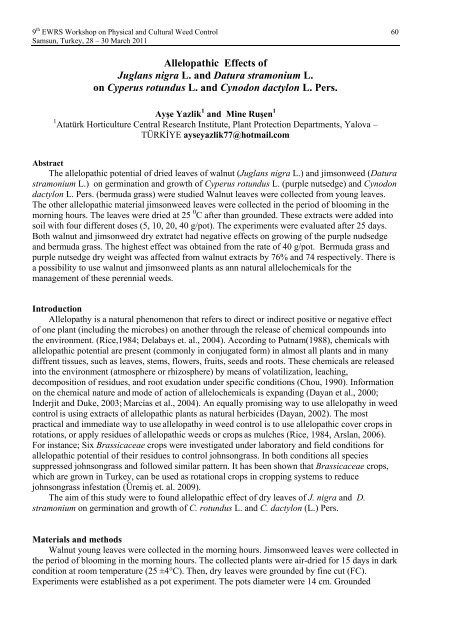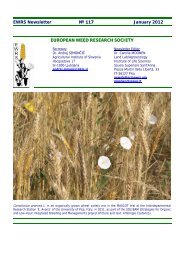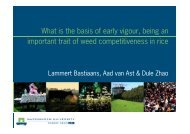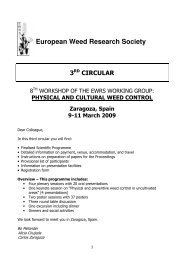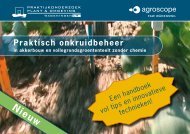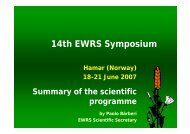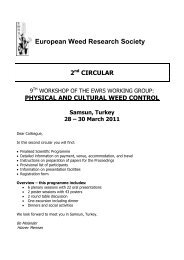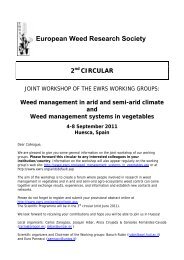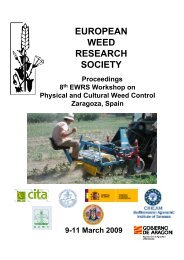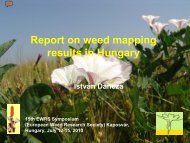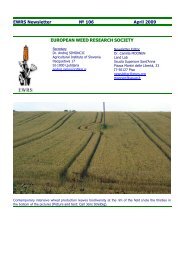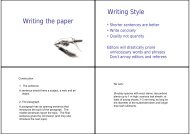Physical and Cultural Weed Control Working Group of - European ...
Physical and Cultural Weed Control Working Group of - European ...
Physical and Cultural Weed Control Working Group of - European ...
Create successful ePaper yourself
Turn your PDF publications into a flip-book with our unique Google optimized e-Paper software.
9 th EWRS Workshop on <strong>Physical</strong> <strong>and</strong> <strong>Cultural</strong> <strong>Weed</strong> <strong>Control</strong> 60<br />
Samsun, Turkey, 28 – 30 March 2011<br />
Allelopathic Effects <strong>of</strong><br />
Juglans nigra L. <strong>and</strong> Datura stramonium L.<br />
on Cyperus rotundus L. <strong>and</strong> Cynodon dactylon L. Pers.<br />
Ayşe Yazlik 1 <strong>and</strong> Mine Ruşen 1<br />
1 Atatürk Horticulture Central Research Institute, Plant Protection Departments, Yalova –<br />
TÜRKİYE ayseyazlik77@hotmail.com<br />
Abstract<br />
The allelopathic potential <strong>of</strong> dried leaves <strong>of</strong> walnut (Juglans nigra L.) <strong>and</strong> jimsonweed (Datura<br />
stramonium L.) on germination <strong>and</strong> growth <strong>of</strong> Cyperus rotundus L. (purple nutsedge) <strong>and</strong> Cynodon<br />
dactylon L. Pers. (bermuda grass) were studied Walnut leaves were collected from young leaves.<br />
The other allelopathic material jimsonweed leaves were collected in the period <strong>of</strong> blooming in the<br />
morning hours. The leaves were dried at 25 0 C after than grounded. These extracts were added into<br />
soil with four different doses (5, 10, 20, 40 g/pot). The experiments were evaluated after 25 days.<br />
Both walnut <strong>and</strong> jimsonweed dry extratct had negative effects on growing <strong>of</strong> the purple nudsedge<br />
<strong>and</strong> bermuda grass. The highest effect was obtained from the rate <strong>of</strong> 40 g/pot. Bermuda grass <strong>and</strong><br />
purple nutsedge dry weight was affected from walnut extracts by 76% <strong>and</strong> 74 respectively. There is<br />
a possibility to use walnut <strong>and</strong> jimsonweed plants as ann natural allelochemicals for the<br />
management <strong>of</strong> these perennial weeds.<br />
Introduction<br />
Allelopathy is a natural phenomenon that refers to direct or indirect positive or negative effect<br />
<strong>of</strong> one plant (including the microbes) on another through the release <strong>of</strong> chemical compounds into<br />
the environment. (Rice,1984; Delabays et. al., 2004). According to Putnam(1988), chemicals with<br />
allelopathic potential are present (commonly in conjugated form) in almost all plants <strong>and</strong> in many<br />
diffrent tissues, such as leaves, stems, flowers, fruits, seeds <strong>and</strong> roots. These chemicals are released<br />
into the environment (atmosphere or rhizosphere) by means <strong>of</strong> volatilization, leaching,<br />
decomposition <strong>of</strong> residues, <strong>and</strong> root exudation under specific conditions (Chou, 1990). Information<br />
on the chemical nature <strong>and</strong> mode <strong>of</strong> action <strong>of</strong> allelochemicals is exp<strong>and</strong>ing (Dayan et al., 2000;<br />
Inderjit <strong>and</strong> Duke, 2003; Marcías et al., 2004). An equally promising way to use allelopathy in weed<br />
control is using extracts <strong>of</strong> allelopathic plants as natural herbicides (Dayan, 2002). The most<br />
practical <strong>and</strong> immediate way to use allelopathy in weed control is to use allelopathic cover crops in<br />
rotations, or apply residues <strong>of</strong> allelopathic weeds or crops as mulches (Rice, 1984, Arslan, 2006).<br />
For instance; Six Brassicaceae crops were investigated under laboratory <strong>and</strong> field conditions for<br />
allelopathic potential <strong>of</strong> their residues to control johnsongrass. In both conditions all species<br />
suppressed johnsongrass <strong>and</strong> followed similar pattern. It has been shown that Brassicaceae crops,<br />
which are grown in Turkey, can be used as rotational crops in cropping systems to reduce<br />
johnsongrass infestation (Üremiş et. al. 2009).<br />
The aim <strong>of</strong> this study were to found allelopathic effect <strong>of</strong> dry leaves <strong>of</strong> J. nigra <strong>and</strong> D.<br />
stramonium on germination <strong>and</strong> growth <strong>of</strong> C. rotundus L. <strong>and</strong> C. dactylon (L.) Pers.<br />
Materials <strong>and</strong> methods<br />
Walnut young leaves were collected in the morning hours. Jimsonweed leaves were collected in<br />
the period <strong>of</strong> blooming in the morning hours. The collected plants were air-dried for 15 days in dark<br />
condition at room temperature (25 ±4°C). Then, dry leaves were grounded by fine cut (FC).<br />
Experiments were established as a pot experiment. The pots diameter were 14 cm. Grounded


